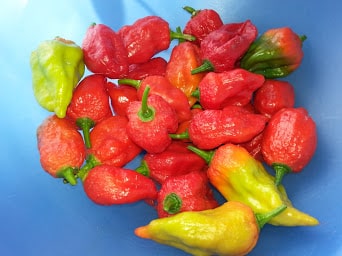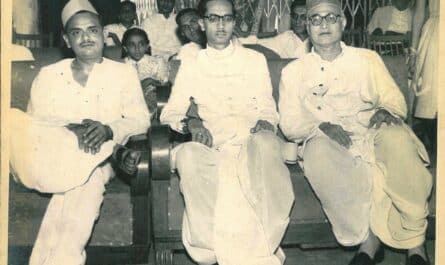The unnamed road that winds its way, one large crater at a time, from the Hell Highway to the Farm is a gentle climb, but a climb nonetheless. A few weeks ago, I decided to pull out the Altimeter app on my phone and check the Farm elevation. I was in luck as the mobile towers weren’t down that day (as they often are), and I had an accurate GPS-assisted elevation.
The Farm doesn’t quite qualify as a Hill Station but stands tall at 204 meters above sea level. When we first bought the land, it was acres of tangled scrub sloping gently down to a patch of flat land that we were told was ideal for paddy cultivation. A narrow village road divides the farm, so we technically have two plots of land on either side of the road. This, of course meant vastly increased fencing costs, the jugglery of getting electric lines and drip irrigation across the road and reduced security.
As we started work cleaning the land and demarcating our boundaries, we found we had a farm that had a 50-meter gradient from its highest point to the lowest point. On one part is a steep chasm where rainwater from the higher reaches flows down and floods the paddy plains. The chasm is unusable on account of the torrents of water, and we have left is as it is. The rest of the land we have slowly terraced and made more usable. While mango, cashew, chickoo and banana trees are planted on almost three-quarters of the land, we are using the remaining land to experiment with vegetables, sweetcorn, peanuts, millets, wheat and rice with varying degrees of success.
In the first few months after we bought the farm, while we waged war with Fiends and struggled to get electric poles installed, we left Manager M the job of identifying a Dowser or Water Diviner to find the possible water sources for our all-important borewells. By way of explanation, a Dowser is someone who uses a divining rod, coconut, forked stick or pendulum to find underground water. They are also known as rhabdomancers or water witches.
Our local Dowser managed the job with aplomb, and we hit ground water at a very shallow 50 feet. Both the points identified by the dowser proved accurate and we dug two borewells on either side of the dividing village road.
Grim S planted all the trees and installed the drip irrigation, and we had adequate water for our plants right through the scorching summer.
Then, a full year after we bought the land, the stars aligned and we managed to get a government land surveyor to clearly and unequivocally demarcate our boundaries. The result of this survey was a mixed blessing. We found we had almost a quarter acre more land than we originally thought we had, but on the downside, both the patches of newly discovered land were at an elevation and our borewells didn’t have enough pressure to get water to the new fields.
So, in late April 2023, we began the process of locating a new water source and digging our third borewell. We spoke to Manager M and Grim S and they in turn spoke to all their sources and contacts. A Hydrologist we were told would charge Rs 16000/- to locate groundwater and a Dowser would charge Rs 1200/-. Both the Hydrologist as well as the Dowser said there was no guarantee we would find water at the spot they indicated. After a brief consultation, we decided to go with the Dowser as he was much cheaper and more importantly, had accurately identified the water location for our earlier two borewells.
So, on the appointed day, we drove up to meet the Dowser and find possible locations for our third borewell.
The dowsing process is truly to be seen to be believed. The Dowser (a perfectly normal-looking gentleman) walked around the farm with a dried coconut lying horizontal in the palm of his right hand. We followed, frowning in his wake asking questions and attempting to video the proceedings. Then, suddenly, the horizontal coconut wiggled a bit and turned upright. All before our very eyes! The Dowser marked the spot with his foot, turned around and approached it from another direction. Et voila, the coconut went erect again. After he checked it a few times more, he asked the Imp to place stones to mark the spot and told us he was reasonably sure we would get water at the spot.
Do take a look at the video
Unfortunately, that spot did not work for us at all. It was at the lowest part of the Farm, almost in line with our first borewell and extremely far from the two fields that weren’t getting water. We persuaded him to take his coconut and locate water closer to the place we needed the water. He stomped the length and breadth of one of the new fields, but the coconut remained resolutely limp. As he continued to walk around, the coconut went erect very close to the edge of the chasm. We dismissed that location as it was too close to the edge and any drilling would cause the soil to erode more rapidly during the heavy monsoon.
By this time, Mr Stonethrower, the Imp and Manager M were bored with the proceedings and entertained themselves by attempting their own dowsing using other coconuts. The Imp’s coconut I believe had several erections at different parts of the farm, while Mr Stonethrower’s coconut remained resolutely limp.
Meanwhile, the real Dowser found another point that was equidistant to the two new fields. This was a point that could work for us we thought and we persuaded the Imp to give up his own dowsing and place a pile of stones at the point indicated by the Dowser.
Then, we crossed the narrow road and asked the Dowser to make one last attempt in the other new field. He paced around determinedly and did find a point, but said it was a false positive and we should ignore it. Don’t ask me. I do not know why he said this.
So, after hours of dowsing, we were left with one location that was no help to us and one possible location that could service both new fields.
A few days later a giant boring machine trundled up to the farm and started drilling. We watched as the drill went down 50 feet, 100 feet, 150 feet…still no water.
We took a brief pause at this stage and got into a huddle. We had reached water at 50 feet in our first two borewells and here at 150 feet, we were still drilling through dry rock. After a quick call to the boss of the boring company, we decided to continue drilling as he said this point was at a higher altitude than the earlier two borewells and since the earth wasn’t throwing up too much dust, it was in all possibility, not completely dry.
So, we continued drilling through the scorching afternoon. 200 feet, 250 feet…we were truly sweating by this point.
Finally, at 300 feet we decided to call it quits. We still hadn’t hit water and drilling any further seemed pointless. All we had to show for our efforts was a plastic casing pipe that jutted a few feet out of the ground. The pipe was ceremoniously sealed, and the boring truck disappeared into the fast-fading light.
At the Farm, we were left with more questions than answers. Had we been naïve to trust a man with a coconut to find a water source? Should we have used the services of a scientific hydrologist? Would the results have been any different? Should we look for another spot or leave that for another day?
We drove home in a sombre, despondent mood.
The next morning though, we were given a glimmer of hope by the borewell company boss. He called to say he was sending across his whopper of a bill, but we should keep our chins up as he was still convinced there was water in the spot we had drilled. He asked the Imp to check after a month by throwing a small pebble down the casing pipe and listening to hear if it struck water.
As we stand today, we have seen the coconut. But have still to see the water.



You’ll find water when he throws the pebble. Wait and watch ❣️
I truly hope so. Thanks:)
Readable and engaging. Well done
Thanks Amit
Really enjoy reading about all of your work on the farm. Keep up the good work and I’m sure water will appear soon.
Thanks Tracy. Yes, keeping fingers crossed on the water